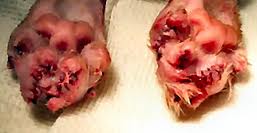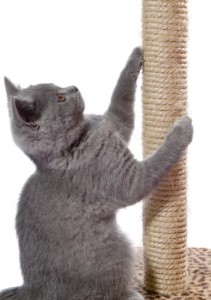The Truth About Declawing
 Declawing is more accurately described as “de-toeing.” It isn’t a nail trim – it’s an amputation of the toe back to the first joint. This is a cruel and unnecessary mutilation. The pain to the cat is categorized as “severe,” surpassing the pain of neutering and even spaying. A majority of cats that are declawed have at least one complication resulting from the surgery, such as
Declawing is more accurately described as “de-toeing.” It isn’t a nail trim – it’s an amputation of the toe back to the first joint. This is a cruel and unnecessary mutilation. The pain to the cat is categorized as “severe,” surpassing the pain of neutering and even spaying. A majority of cats that are declawed have at least one complication resulting from the surgery, such as (but not limited to) nerve damage, hemorrhage, bone chips, and deformed claw regrowth, and over a third of declawed cats develop behavior problems afterwards.
(but not limited to) nerve damage, hemorrhage, bone chips, and deformed claw regrowth, and over a third of declawed cats develop behavior problems afterwards.
A cats claws are used for balance, exercise, and stretching the muscles of their paws, legs, shoulders, and back. This means that a declawed cat can no longer walk properly or stretch it shoulder muscles. Cats often become lame. Many develop sway back from being unable to walk and exercise normally. They have chronic back, leg and paw pain. Many develop arthritis and even develop painful bone spurs from their unnatural posture.
Cats’ claws are also their main mechanism of defense against predators (be it scratching or climbing to escape the situation). When a cat is declawed, the dangers from other creatures is much increased.
Although the scratching of furniture may be avoided after a cat has been declawed, it is quite likely that the cat will develop other ‘bad’ behaviors that are even more difficult to deal with. Because many cats develop an aversion to the litter box after declawing, the person who had their cat declawed to avoid having their furniture scratched may find that they have a cat that is fearful, in pain, and pees around the house.
Many people report a severe change in a cat’s personality after being declawed. Some become more agitated and aggressive while others become withdrawn and scared (after all, they are now left without their natural defense system). Your once loving and friendly cat may become remote and reclusive, or it might start to attack you or other animals in the house. Declawed cats tend to become biters. Those parents who think they will avoid the possibility of their children being scratched by declawing the cat may find themselves with a cat that bites.
Many declawed cats develop litter box issues or have territory issues. Declawed cats develop inappropriate urination habits because they are stressed by general chronic pain, and because scratching litter causes additional pain in their paws. So if the normal activity of scratching in the box causes them to hurt, they may stop using the box and seek out soft surfaces, such as furniture or rugs or clothing to urinate on.
Because walking and jumping may be painful for the declawed cat, it tends to become more sedentary and to gain weight. As the cat gets heavier, the pressure on its feet is greater and the pain increases. Eventually your declawed cat may become quite overweight and very inactive. This creates a whole store of health problems for the cat.
Declawing a cat is an extreme surgery and has many negative consequences that may never be overcome. Many cats become such different, and difficult, creatures after declawing that the family discards them at the pound or has them euthanized. The results of declawing can be horrific and it is unconscionable for anyone to do this to an animal for selfish and frivolous purposes such as ‘saving’ the furniture.
A growing number of vets, pet owners and other animal advocates are working to help the general public understand what declawing, or onychectomy, really involves and how it can negatively affect a cat’s life. The procedure is against the law in many countries outside the U.S. and in some areas of the states. Although recognized as an inhumane practice by most animal rights and humanitarian groups, it remains legal in much of the U.S. largely due to the lack of understanding by people about what this procedure actually is, and the lobbying efforts of veterinarian groups who profit from performing this surgery.
There are many steps cat owners can take to prevent inappropriate clawing, including providing kitties with approved scratching surfaces, and using safe, effective deterrents to redirect cats away from inappropriate surfaces.
Cat-Friendly Solutions:
 Provide your cat with a variety of acceptable scratching sites in different parts of your home. Carpet, sisal, and corrugated cardboard are all popular choices that are relatively cheap. You don’t need to buy a fancy cat tree (although I don’t think a cat would complain!) or anything grand — you just need to make sure the cat has a place where it is okay to scratch. Cat nip is a good way of attracting a cat to the surface initially. Remember that some cats prefer scratching on a horizontal surface and some prefer a vertical surface. If you get a cat scratching post and your cat is a horizontal scratcher, it may continue to scratch the carpet and chair seat.
Provide your cat with a variety of acceptable scratching sites in different parts of your home. Carpet, sisal, and corrugated cardboard are all popular choices that are relatively cheap. You don’t need to buy a fancy cat tree (although I don’t think a cat would complain!) or anything grand — you just need to make sure the cat has a place where it is okay to scratch. Cat nip is a good way of attracting a cat to the surface initially. Remember that some cats prefer scratching on a horizontal surface and some prefer a vertical surface. If you get a cat scratching post and your cat is a horizontal scratcher, it may continue to scratch the carpet and chair seat.
Aversion methods are also a useful solution. Use double-stick tape on furniture that’s frequently scratched by your cat. The sticky feel will be unpleasant for the cat, but not harmful. Aluminum foil is also effective at deterring cats from scratching. If a cat still insists on trying to scratch inappropriate surfaces, a squirt gun can implement classical conditioning which will have them associate scratching that place with something unpleasant. There are also a number or products sold containing citrus or other scents unpleasant for cats that can be sprayed in the areas that you do not want scratched.
Regular nail trimming can help get rid of a razor sharp nail. If you decide to trim a cat’s nails, remember not to trim them too closely or you may risk hurting your cat. (A good way to know is to cut where the nail is clear, not opaque or pink). Take your time in doing this. If it doesn’t work and you can’t trim them all, release the cat and trim the rest later.
 Nail covers such as Soft Paws © are another solution. Soft Paws © are vinyl caps that go over a cats nails and help save your furniture. They come in a variety of colors and last 4-6 weeks. These should be used sparingly on cats that go outside as they hinder the defense mechanism. And they should be used only intermittently, to train the cat. A cat’s claws need to breathe and if nail covers are left on too long, they can create an environment for fungal and bacterial infections.
Nail covers such as Soft Paws © are another solution. Soft Paws © are vinyl caps that go over a cats nails and help save your furniture. They come in a variety of colors and last 4-6 weeks. These should be used sparingly on cats that go outside as they hinder the defense mechanism. And they should be used only intermittently, to train the cat. A cat’s claws need to breathe and if nail covers are left on too long, they can create an environment for fungal and bacterial infections.
As you can see, there are many reasons not to maim your cat by surgical declawing, and plenty of alternative solutions to the reasons for considering it.
HAVE A HEART! DON’T DECLAW!
CCCR does NOT allow declawing of our cats. Every adopter is required to sign an ‘no-declaw’ agreement that is legally binding. But we do rescue and adopt out cats who are declawed. If you have a declawed cat with litter box or other issues, or even if you don’t think your cat has a problem, check out our suggestions below to help your cat be healthier and happier.
HELPFUL SUGGESTIONS IF YOU HAVE A DECLAWED CAT
The first thing to recognize with your declawed cat is that it is most likely in pain. Helping to alleviate as much of that pain as possible is a first step toward having a well adapted and happy cat.
Fish oil is a safe and easy anti-inflammatory to give your cat. If can be added to wet food easily and most cats will eat it without a problem. Start with a small amount to help the cat’s digestive adjust, and work up to a capsule a day. It does tend to soften a cat’s stools, which often is a benefit for more sedentary declawed cats. You can buy the capsules sold for humans, prick open the capsule and squeeze the oil onto the food. Some cats will eat it directly from your finger or a plate.
Glucosamine is an excellent supplement to give to a cat with joint problems related to age, injury or declawing. It helps with inflammation of the joints. You can buy it in powdered form in a can at some pet stores. Or you can buy capsules of the powder made for human consumption; simply open the capsule and dump the powder onto the cat’s canned food, mix in. Most pet stores also sell glucosamine treats that some cats love as a daily snack. It can take weeks or even a month, but once the glucosamine and fish oil begin to work, you should begin to see a difference in your cat’s activity level.
Some cats are in so much pain and have such complications, such as bone spurs, from the declawing that they may need pain relievers or other care that requires a vet visit.
If your cat is overweight, it may be necessary to help the cat with a ‘diet’. This would include a protein rich, low-carbohydrate food; more canned food and less free feeding of dry food. Because many overweight cats have elimination problems, adding more fiber to the diet is helpful as well. Raw chicken wings with the bones is a good healthful food and chew toy. Also oat or wheat grass for the cat to chew on will aid the cleansing of the cat’s digestive system.
It’s important to help your cat exercise to keep it strong and healthy. So encouraging play with a string or laser light, or even a balled up wad of paper, will be beneficial. Play is important not only for the cat’s physical health, to lose weight and stay in shape, but it is exhilarating for the spirit as well and can change a depressed cat’s attitude about life.
SOLVING LITTER BOX PROBLEMS
When anyone calls to say that their cat is peeing outside the litter box , my first question is ‘Is your cat declawed?’ and the majority of the answers are ‘yes’. Not using the litter box is a VERY common result of declawing.
If your declawed cat is avoiding the litter box, the kind of litter could be the problem. First you have to consider that the cat could have a urinary tract infection or kidney problem, and they should be checked by a vet. But ‘normal’ chronic pain from the declawing is often the cause.
Clumping and even non-clumping clay litter is hard and can cause pain when a declawed cat tries to scratch in it. Using a soft litter can make a difference. Shredded paper seems to work well for some cats. Plain potting or garden soil is used by some people as a litter substitute; it is a hit with most cats, being a totally natural substance for them to scratch around in. Dr Easley’s litter, which is softer, seems to be acceptable to many declawed cats. You can also buy the can of litter attractant to add to whatever product you use as litter to encourage the cat to use that particular place as a potty.
Once you find an acceptable litter that does not hurt the cat’s feet, it may still be necessary to re-train the cat to use the box. The litter attractant can help with this but that may not be enough. You may need to use a different litter box and put it in a different place in the house. Encouragement rather than punishment is most effective. Remember that the cat already connects the box with pain so it is important to provide some positive feedback when the cat does use the box; maybe even a little treat when it goes in the box.
OVERCOMING DEPRESSION
Many declawed cats become dispirited and depressed. This is due to many factors but pain is a major cause. Helping the cat with pain relief is a first step in helping your cat feel happier. The supplements mentioned above may help, or vet prescribed pain medication. Sometimes it takes short term use of pain medication to allow the cat to start to move about again, regain the use of their muscles, lost weight, get in the habit of being active rather than sedentary, and to feel like life is worth living.
It can be helpful to engage your cat in play. Make an effort to spark the cat’s interest in going after a string even if it just bats at it with its paws without getting up. Help get it started on enjoying life. Pleasant interactions with you can make a difference.
Your declawed cat’s attitude may also be improved by allowing the cat to go outside more often. It’s true that the dangers of predators are greater for a declawed cat. But adding the punishment of complete housebound imprisonment to the trauma and pain of declawing can so destroy a cat’s spirit that it may never be a joyful happy cat again. Allowing the cat to have a pleasant outside experience– soft grass to walk on, the warm sun to lay in, and scents on the wind to explore can make all the difference in a cat’s attitude and quality of life. Many declawed cats still hunt and are good at it. Some declawed cats climb trees. Making the cat’s life as close to ‘normal’ as possible can help it feel and act more like a normal cat.


